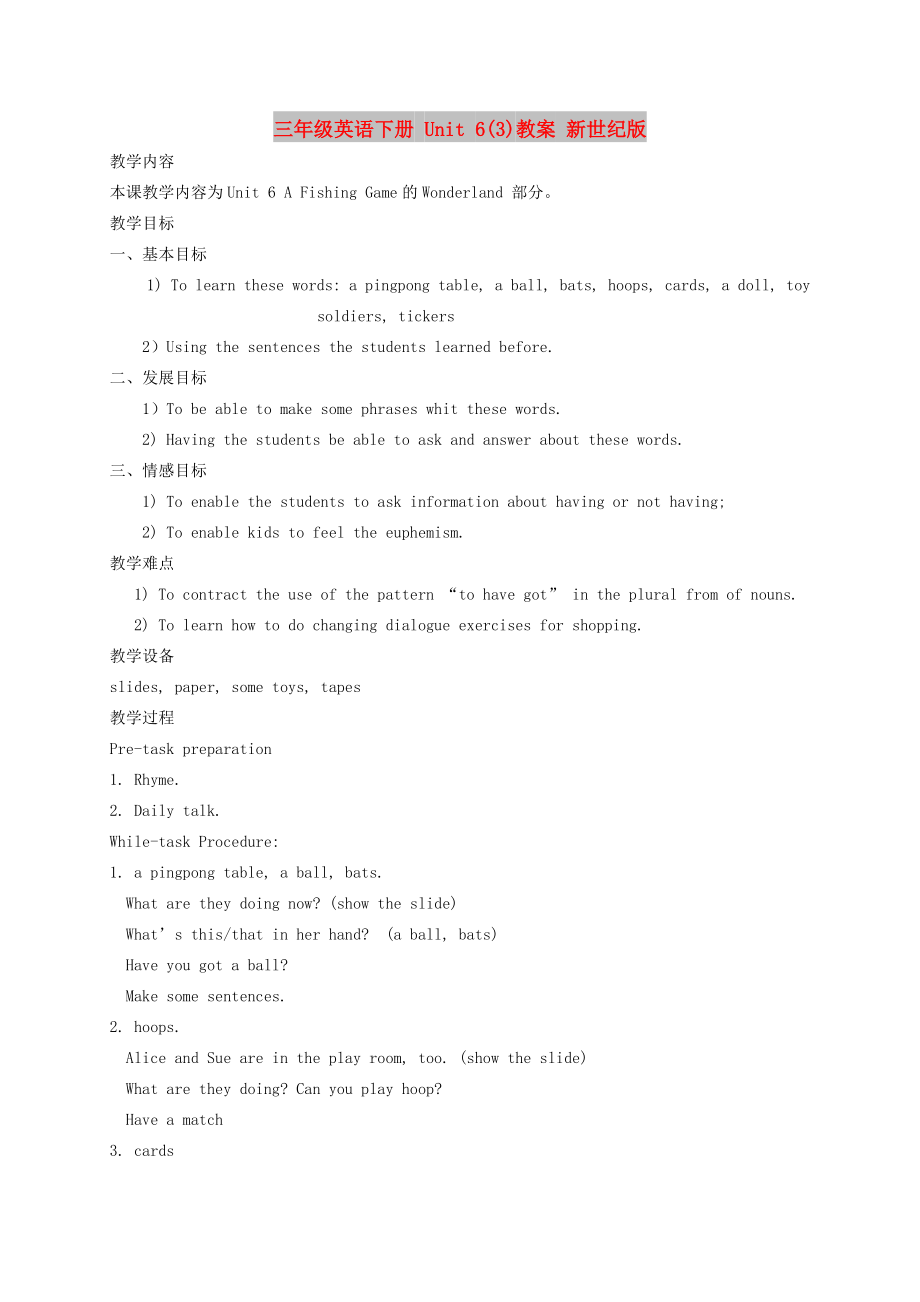《三年級(jí)英語(yǔ)下冊(cè) Unit 6(3)教案 新世紀(jì)版》由會(huì)員分享�,可在線閱讀,更多相關(guān)《三年級(jí)英語(yǔ)下冊(cè) Unit 6(3)教案 新世紀(jì)版(4頁(yè)珍藏版)》請(qǐng)?jiān)谘b配圖網(wǎng)上搜索����。
1、三年級(jí)英語(yǔ)下冊(cè) Unit 6(3)教案 新世紀(jì)版
教學(xué)內(nèi)容
本課教學(xué)內(nèi)容為Unit 6 A Fishing Game的Wonderland 部分�����。
教學(xué)目標(biāo)
一����、基本目標(biāo)
1) To learn these words: a pingpong table, a ball, bats, hoops, cards, a doll, toy soldiers, tickers
2)Using the sentences the students learned before.
二、發(fā)展目標(biāo)
1)To be able to make some phrases whit these wo
2��、rds.
2) Having the students be able to ask and answer about these words.
三、情感目標(biāo)
1) To enable the students to ask information about having or not having;
2) To enable kids to feel the euphemism.
教學(xué)難點(diǎn)
1) To contract the use of the pattern “to have got” in the plural from of nouns.
2) To learn
3�����、how to do changing dialogue exercises for shopping.
教學(xué)設(shè)備
slides, paper, some toys, tapes
教學(xué)過(guò)程
Pre-task preparation
1. Rhyme.
2. Daily talk.
While-task Procedure:
1. a pingpong table, a ball, bats.
What are they doing now? (show the slide)
What’s this/that in her hand? (a ball, bats)
4�����、Have you got a ball?
Make some sentences.
2. hoops.
Alice and Sue are in the play room, too. (show the slide)
What are they doing? Can you play hoop?
Have a match
3. cards
What else can you play?
I’ve got some cards. Can you play cards?
What have you got? I’ve got King /Queen/ Ja
5�����、ck.
4. a doll
A riddle: In the play room, who is sitting on the chair?
Have you got a doll ? Can you describe your doll?
5. toy soldiers
What can you hear?
There must be somebody in the next room. Let’s go and see.
Have you got toy soldiers?
6. stickers
Have you got any stickers
6�����、? / How many stickers have you got?
Post-task Activities
1. What toys do girls /boys like? What toys have you got?
2. Read the words and do some excises
3. Game.
4. Make dialogues.
附送:
2019-2020年三年級(jí)英語(yǔ)下冊(cè) Unit 6(30)教案 人教PEP
【教學(xué)重點(diǎn)】在情景中運(yùn)用small, big, long, short, tall����。
【教學(xué)難點(diǎn) 】have 和 has 的
7、對(duì)比和運(yùn)用�,讓學(xué)生在練習(xí)中得以掌握。
【教具準(zhǔn)備】
1 教師準(zhǔn)備教材配套的錄音帶�。
2 教師準(zhǔn)備Let’s talk / A 部分的教學(xué)課件。
3 教師準(zhǔn)備第一冊(cè)Unit 4 B Let’s chant 的磁帶。
4 教師準(zhǔn)備所學(xué)動(dòng)物類單詞卡片(或玩具)和圖片����。
5 學(xué)生準(zhǔn)備相關(guān)的動(dòng)物玩具及面具����。(每人至少一個(gè))
【教學(xué)過(guò)程 】
1 熱身、復(fù)習(xí) (Warm-up/Revision)
(1)日?�?谡Z(yǔ)練習(xí)���。
(2)教師播放第一冊(cè)Unit 4 B Let’s chant 的錄音帶�����。將cat, pig, monkey, mouse 的圖片貼在
8���、黑板上。學(xué)生邊指圖邊跟錄音復(fù)習(xí)歌謠�,還可以做出相應(yīng)的動(dòng)作。通過(guò)此歌謠可以復(fù)習(xí)Look at …的句型���, 以及big, fat, funny 等單詞��。
2 呈現(xiàn)新課 (Presentation)
(1)教師為學(xué)生播放本單元第一課時(shí)的教學(xué)課件�,復(fù)習(xí)單詞big, long, short, small, tall。
(2)了解so 的用法����。
學(xué)生讀完Unit 4 B Let’s chant 的歌謠后, 教師從黑板上取下pig 的圖片�����,對(duì)學(xué)生說(shuō):Look at the pig. It’s so big. 強(qiáng)調(diào)so 的語(yǔ)調(diào)��,并加以“大”的手勢(shì)�����。接著�����,教師拿下mouse 的圖片�,對(duì)學(xué)
9、生說(shuō):Look at the mouse. It’s small. It’s so … 示意學(xué)生說(shuō)出:It’s so small. 同樣�,教師做出“小”的手勢(shì)。讓學(xué)生體會(huì) so 在句子中的意思是:“強(qiáng)調(diào)某種程度”���。
(3)教師出示單詞卡片或?qū)嵨飳?duì)比的方法��,再次認(rèn)讀并復(fù)習(xí)表示大小�、長(zhǎng)短的單詞big, long, short, small, tall。
(4)教師播放Let’s talk / A 部分的教學(xué)課件�����,讓學(xué)生初步了解對(duì)話含義����。
(5)根據(jù)學(xué)生對(duì)課件的記憶以及平日生活中的觀察����,讓學(xué)生說(shuō)說(shuō)大象的眼睛、鼻子以及整體的樣子����。
S: The elephant has a l
10、ong nose. It has big ears. It has a short tail. It is (so)big. 教師引導(dǎo)學(xué)生將這些句子用and連接在一起����,并帶讀:Look at the elephant, It’s so big. It has a long nose and a short tail. It has small eyes and big ears.
6)再次觀看Let’s talk / A 部分的教學(xué)課件, 讓學(xué)生跟讀對(duì)話中的句子����,模仿發(fā)音����,要求自然生動(dòng)�。
3 趣味操練 (Practice)
(1)將課件中的聲音關(guān)閉,為其中的人物配音�����。
11�����、(2)讓學(xué)生拿出事先準(zhǔn)備好的玩具�����。先將學(xué)生手中的各個(gè)玩具單詞說(shuō)一說(shuō)����,然后教師做示范:請(qǐng)一名學(xué)生上講臺(tái)前,教師指著學(xué)生手中的玩具說(shuō):A monkey. Look at the monkey. It has small ears. It has big eyes and long tail. (etc.)之后���,請(qǐng)幾個(gè)能力較強(qiáng)的學(xué)生說(shuō)說(shuō)手中動(dòng)物玩具的樣子����。
(3)讓學(xué)生以小組為單位,繼續(xù)練習(xí)簡(jiǎn)單形容自己�����、他人或小動(dòng)物的情況�。在此處,教師提示學(xué)生注意:形容自己時(shí)說(shuō): I have big eyes and small mouth. I have ….
形容他人時(shí)說(shuō): He/She ha
12��、s long hair.
形容小動(dòng)物時(shí)說(shuō): It has a long nose.
(4)教師請(qǐng)每組派一名學(xué)生到講臺(tái)前表述組里的人或小動(dòng)物玩具�����。如:
Look at the monkey.
It’s so funny.
It has a long tail and a big mouth.
It has big eyes and a small nose.
Or:
Look at Mary(Mike/Tom).
She has big eyes and small nose.
She has long hair.
She is
13����、happy.
(5)做Let’s practise 部分的練習(xí)����。
按照課本中所呈現(xiàn)的方式,教師先拿出一個(gè)小豬的面具����,請(qǐng)一名學(xué)生到講臺(tái)前戴上面具�����,扮演“小豬”�,說(shuō):I have …. 接著��,教師可以讓另一名學(xué)生轉(zhuǎn)述“小豬”的話��,如:Look, it has big nose and small eyes. 教師帶領(lǐng)學(xué)生做游戲�����,通過(guò)游戲的形式讓學(xué)生連鎖記憶�����,從而復(fù)習(xí)鞏固介紹自己����、他人或小動(dòng)物情況的句子。
4 課堂評(píng)價(jià) (Assessment)
做活動(dòng)手冊(cè)第35頁(yè)的練習(xí)�����,方法和步驟同以前�。
5 擴(kuò)展性活動(dòng)(Add-activities)
教師把學(xué)生帶到室外���,做傳球說(shuō)物的游戲。
將學(xué)生分為3—4組�����,每組圍成一個(gè)圈��,每圈的學(xué)生分一個(gè)氣球�,學(xué)生聽(tīng)音樂(lè)作傳球活動(dòng),當(dāng)音樂(lè)停止時(shí)���, 手中拿到球的學(xué)生則抽取問(wèn)題����,問(wèn)題的內(nèi)容為:形容某某人或某某小動(dòng)物���。回答問(wèn)題的同學(xué)用Look at …. It has…. It’s so…. 或 Look at …. He/She has…. He/She is so …. 的句子來(lái)表述��。
 三年級(jí)英語(yǔ)下冊(cè) Unit 6(3)教案 新世紀(jì)版
三年級(jí)英語(yǔ)下冊(cè) Unit 6(3)教案 新世紀(jì)版

